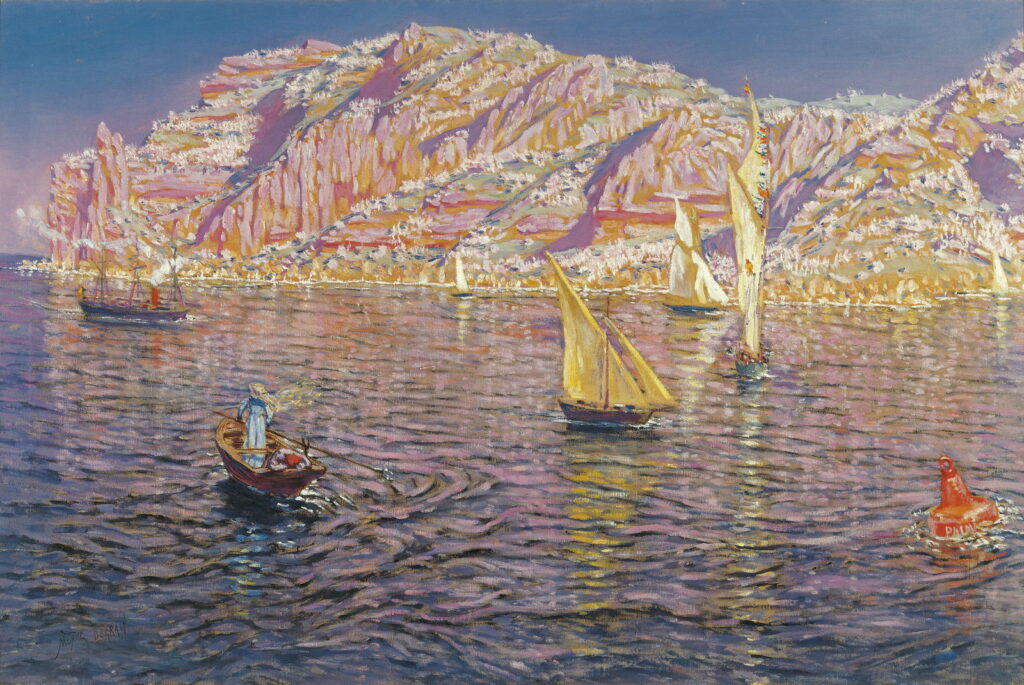In memoriam Antonio Muñoz Degrain, who died 100 years ago

A century ago today, 12 October, the Spanish painter Antonio Muñoz Degrain (1840–1924) died in Málaga, Spain. Although now largely forgotten outside his native country, he was an accomplished artist and achieved international recognition. Of the relatively few of his works that remain accessible, there are several that are striking and individual.
He was born in Valencia, Spain, and started his studies at the Real Academia de Bellas Artes de San Carlos there, before abandoning them and travelling to Rome, where he largely taught himself. He then returned to Spain, where he started exhibiting his landscapes in 1862.
Antonio Muñoz Degrain (1840–1924), Landscape of El Pardo as the Fog Clears (1866), oil on canvas, 200 x 300 cm, Museo Nacional del Prado, Madrid, Spain. Wikimedia Commons.
Muñoz Degrain’s early Landscape of El Pardo as the Fog Clears from 1866 is set in El Pardo Mountain Reserve, the hunting grounds of the Spanish royal family, where one of its rangers is taking his horse to water. The mountain in the background is Guadarrama, which is surprisingly alpine and rugged. His style is detailed realist, perhaps a little behind the times.
He developed his skills as a narrative painter with a series of commissioned historical works, including a painting of Queen Isabella with Christopher Columbus, for which he was awarded the Grand Cross of the Order of Charles III.
Antonio Muñoz Degraín (1840–1924), Othello and Desdemona (1880), media not known, 272 x 367 cm, Museu Nacional de Arte Contemporânea do Chiado, Lisbon, Portugal. Wikimedia Commons.
In 1880, he started painting a series showing the climax of William Shakespeare’s play Othello. The first, Othello and Desdemona shows Othello entering Desdemona’s bedchamber to find her asleep.
Muñoz Degrain returned to Rome in 1882 on a two-year fellowship.
Antonio Muñoz Degrain (1840–1924), The Conversion of Recaredo (1888), oil on canvas, 350 x 550 cm, Palacio del Senado de España, Madrid, Spain. Wikimedia Commons.
In 1888, he appears to been commissioned to depict The Conversion of Recaredo for the Palace of the Spanish Senate in Madrid. This shows Reccared I (c 559-601) abandoning Arianism and converting to Catholicism during the Third Council of Toledo in 589. This was organised by Saint Leander but convened in the name of Reccared, the Visigothic King of Hispania and Septimania. The king had already renounced Arianism in January 587, and his public confession was read aloud at the council, which marked the start of his new Catholic kingdom.
The details of jewellery and costume in this painting are extraordinary.
Ten years later, he was appointed chair of landscape painting at the prestigious Real Academia de Bellas Artes de San Fernando in Madrid, where he became its director in 1901.
Antonio Muñoz Degrain (1840–1924), Port of Bilbao (1900), oil on canvas, 83 x 129.5 cm, Museo Carmen Thyssen Málaga, Málaga, Spain. Wikimedia Commons.
Over this period, his landscape paintings had grown steadily more painterly, although this view of the Port of Bilbao from 1900 remains in the earth colours of Barbizon rather than the bright hues of Impressionism.
Antonio Muñoz Degrain (1840–1924), Washerwomen (1903), oil on canvas, 62 x 98 cm, Museo Carmen Thyssen Málaga, Málaga, Spain. Wikimedia Commons.
In Washerwomen just three years later, he has become full Impressionist, with profuse visible brushstrokes and higher chroma.
Antonio Muñoz Degrain (1840–1924), Seascape View of Palma de Mallorca (1905-10), oil on canvas, 89 x 133.5 cm, Museo Carmen Thyssen Málaga, Málaga, Spain. Wikimedia Commons.
A few years on, between 1905-10, his Seascape View of Palma de Mallorca is almost Fauvist, with a rich range of textures.
Antonio Muñoz Degrain (1840-1924), View of the Alhambra (1914), oil on canvas, 125 x 83 cm, Museo de Málaga. Wikimedia Commons.
Muñoz Degrain’s view of the Alhambra from Albaicin District from 1914 is remarkable for the rhythm established by the poplar trees around its base, which become an integral part of the fortified ridge.
Antonio Muñoz Degrain (1840-1924), View of the Alhambra (date not known), further details not known. Wikimedia Commons.
Finally, his undated View of the Alhambra is one of my favourite paintings of this motif, for its intriguing foreground details, and the poplars lit as white-hot pokers in the fiery light of sunset.
Muñoz Degrain died in Málaga on 12 October 1924, at the age of eighty-three.